Memory Performance

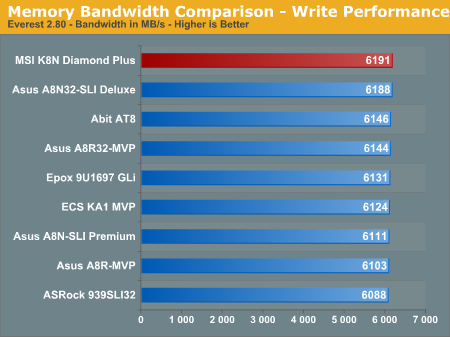
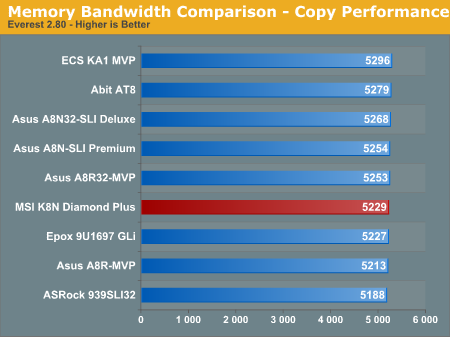
We recently switched to version 2.80 of Everest so these scores are not comparable to previous tests with version 2.50. We have also added the memory copy bandwidth benchmark to our test suite. The read and write scores of the MSI K8N Diamond Plus are excellent and account for the consistent performance of this board in our benchmarks. The memory copy performance is average within the class but can be tweaked for improved performance through the extensive memory options available in the BIOS.
Overclocking Performance
The overclocking performance graphs allow for a better comparison on the overclocking capabilities of previously tested boards. For more details on the specific overclocking abilities of this board please refer to the Overclocking and Memory Stress Test section in the Basic Features section.
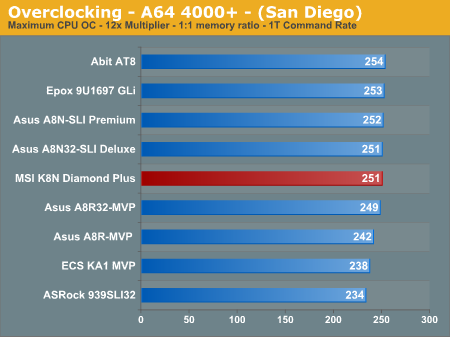
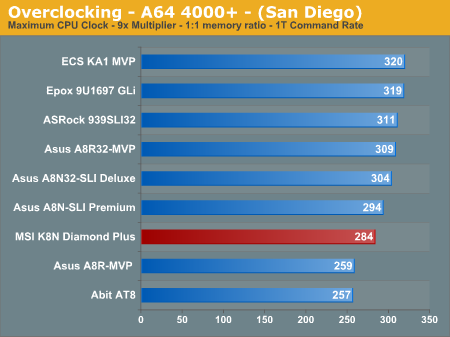
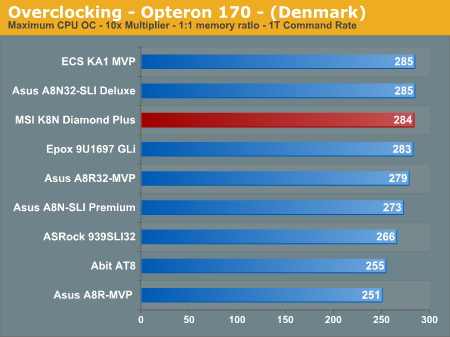
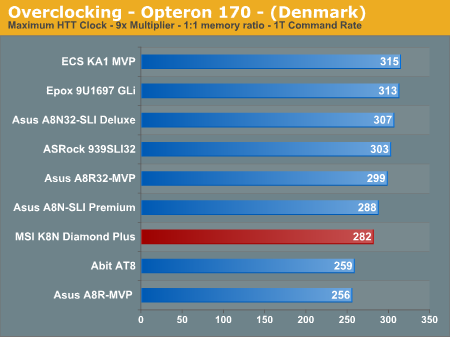
The MSI K8N Diamond Plus is a very good overclocking platform at the stock multiplier settings for our AMD Athlon64 4000+ CPU. We had no issues booting into Windows XP at 256HTT x12 settings and running our 3DMark/game benchmarks but the system was not Prime95/MemTest86 stable for more than four hours unless we dropped to a 251HTT x 12 setting. This is still an excellent result and attests to the quality of components utilized on the board. The same holds true for our AMD Opteron 170 at the stock 10x multiplier as we easily reached a 284HTT x10 setting that was extremely stable.
However, the ability of the MSI K8N Diamond Plus to stably overclock our Athlon64 4000+ or Opteron 170 CPUs higher HTT settings was a disappointment. We tried various voltage settings, LDT multipliers, and memory modules but the system remained unstable at any HTT setting higher than 284. We were never able to reach a 300HTT setting although an Asus A8N32-SLI board utilizing the same chipset was able to break this barrier. Hopefully our test results are due to a less than average board and not a pattern as the 3.0a BIOS has enabled other users to pass the 300HTT setting. In the end, we have to advise caution if you're expecting to overclock the HyperTransport bus to 300 MHz or higher; some boards reach that level apparently, but our particular board did not.



We recently switched to version 2.80 of Everest so these scores are not comparable to previous tests with version 2.50. We have also added the memory copy bandwidth benchmark to our test suite. The read and write scores of the MSI K8N Diamond Plus are excellent and account for the consistent performance of this board in our benchmarks. The memory copy performance is average within the class but can be tweaked for improved performance through the extensive memory options available in the BIOS.
Overclocking Performance
The overclocking performance graphs allow for a better comparison on the overclocking capabilities of previously tested boards. For more details on the specific overclocking abilities of this board please refer to the Overclocking and Memory Stress Test section in the Basic Features section.




The MSI K8N Diamond Plus is a very good overclocking platform at the stock multiplier settings for our AMD Athlon64 4000+ CPU. We had no issues booting into Windows XP at 256HTT x12 settings and running our 3DMark/game benchmarks but the system was not Prime95/MemTest86 stable for more than four hours unless we dropped to a 251HTT x 12 setting. This is still an excellent result and attests to the quality of components utilized on the board. The same holds true for our AMD Opteron 170 at the stock 10x multiplier as we easily reached a 284HTT x10 setting that was extremely stable.
However, the ability of the MSI K8N Diamond Plus to stably overclock our Athlon64 4000+ or Opteron 170 CPUs higher HTT settings was a disappointment. We tried various voltage settings, LDT multipliers, and memory modules but the system remained unstable at any HTT setting higher than 284. We were never able to reach a 300HTT setting although an Asus A8N32-SLI board utilizing the same chipset was able to break this barrier. Hopefully our test results are due to a less than average board and not a pattern as the 3.0a BIOS has enabled other users to pass the 300HTT setting. In the end, we have to advise caution if you're expecting to overclock the HyperTransport bus to 300 MHz or higher; some boards reach that level apparently, but our particular board did not.










42 Comments
View All Comments
Odeen - Wednesday, April 12, 2006 - link
Hi,I wish you guys would post the EXACT BIOS (and, as necessary, jumper) settings you used to achieve your best overclocks, plus any issues you had with certain settings, etc. I'd love to see the actual notes from the lab, i.e. "Tried this clock skew value, crashed after X minutes."
While this wouldn't solve every overclocker's question, it would at least set us on the right path in optimizing our own systems, in terms of how certain values affect things.
I imagine you guys have a better understanding on what the BIOS settings do, as opposed to us everyday enthusiasts, who operate primarily on coincidences and conjectures. Especially in this age of hyper-tweakable motherboards with more and more components, it'd be really nice to know, for example, whether the hypertransport multiplier between the "NB" and the "SB" should match the chip-NB hypertransport multiplier, or whether that hypertransport bus speed is independent of HTT, and can be kept at 200/5X regardless of HTT value.
Lastly, have you tried the firewall drivers on this board, and does the firewall STILL cause bluescreens and corrupt downloads?
Gary Key - Wednesday, April 12, 2006 - link
We will need a new server to handle the notes sections for some of these boards. ;-)
We are probably heading in this direction shortly, especially for the enthusiast level boards. I will see what we can do on the next enthusiast level board with a table chart and short descriptions on how we arrived at the settings. I will say this, sometimes leaving most of the settings on Auto works best, the board/bios engineers are usually very smart about the default settings and then when you think all is okay, they hit you with a setting that should never be a default item.
We found on the MSI board, the NB-SB, SB-NB, and CPU-NB HT settings had to be synchronized or the board had stability issues. In fact, the CPU-NB default setting was at 800MHz, we had to change the option to manual, and then bump it up to 1000MHz to match the NB-SB and SB-NB HT settings at stock speeds. It does appear we had an average or below average board for the review, the latest retail sample that MSI pulled from their warehouse was able to post at 318HTT x9 with our test components.
If they are more details you would like to know, please comment or email me.
We tried the firewall with the 6.85 drivers. We could only recreate one particular situation that resulted in a corrupt download. It required the use of BitComet, downloading seven plus files (each over 200MB) concurrently, transferring the files to a media folder, and then unzipping a file while three others were still downloading. It only did it once but it did do it, is it NVIDIA or something else? I personally have not experienced any BSODs or corrupt downloads with the latest drivers, a clean load of XP, and staying away from the P2P software.
We have a new NVIDIA Business Platform system on its way so it should be interesting to see the tweaked ActiveArmor suite and driver updates that NVIDIA has been working on extensively over the last ninety days.
Gary Key - Wednesday, April 12, 2006 - link
Just not my week....Should read - If there are more details you would like to know, please comment or email me.
slashbinslashbash - Tuesday, April 11, 2006 - link
PLEASE learn the difference between "discreet" and "discrete".JarredWalton - Tuesday, April 11, 2006 - link
I don't know about you, but I like my audio solutions to be unobtrusive. Nothing worse than audio that gets in your face with static and stuff.... ;)mbhame - Tuesday, April 11, 2006 - link
"Our initial impression of the MSI K8N Diamond Plus upon opening the box is that it has an extensive feature list, cluttered yet clean layout, heat-pipe cooling system, and that the overall quality of components utilized by MSI is very good."...how can a layout be 'cluttered yet clean'?
JarredWalton - Tuesday, April 11, 2006 - link
Cluttered in that there is a LOT of stuff; clean in that it still works and there aren't any issues with connecting everything. It's an oxymoron, like "little giant". :)nullpointerus - Tuesday, April 11, 2006 - link
Now I know how to describe my room.nullpointerus - Tuesday, April 11, 2006 - link
Where are these PCIe 1x cards I've been hearing about? What exactly is available on PCIe besides video/network cards? I've heard that it's going to be a very long, slow transition to PCIe for sound cards due to noise/power issues with the spec.DigitalFreak - Tuesday, April 11, 2006 - link
See http://www.siig.com/productList.asp?pid=1013&c...">this page for examples. I do wish they made PCI-E sound cards though.